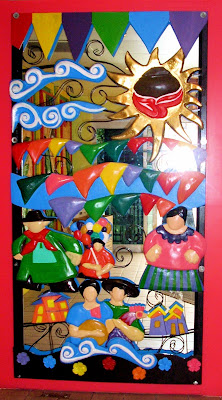
Sharon Leal, Janet Jackson and Tasha Smith in "Why Did I Get Married?"
Photo: Lions Gate Films
“Why did I get married?” Tyler Perry’s new film debuted at number one, grossing $21.5 million this past weekend. It beat out films starring George Clooney, Joaquin Phoenix, and Cate Blanchett. This movie’s instant success was a surprise because Perry’s film features an all African American cast not starring in a comedy.
“For African American filmmakers, an equally big issue today is the widening gulf between the commercial acceptance of black comedy and black drama. In both film and television, it is relatively easy to launch a raucous comedy, but it is often a Herculean task to persuade a studio to greenlight an African American family story or a drama involving race relations,” wrote Patrick Goldstein of The LA Times.
Perry depicts African American culture in a dignified way that does not play on stereotypes. He creates characters that are three dimensional, that all audiences can appreciate. He is inviting America to view African Americans in a more realistic way than the stereotypical gangster or drug dealer.
Ultimately he is creating social acceptance for African Americans that has translated to box-office success. And with that success, the doors will be opened for other ethnicities to follow.
If a drama starring an all African American cast result in box office success, studio heads will produce more films with realistic portrayals of African Americans.
And if more movies like this are successful, film studios will more likely finance a movie that depicts Latinos and Asians in a realistic, non-stereotypical way, because they realize there is market for these types of films.
You might disagree with that previous statement, but think of it this way...
"Why did I get married?" is about four black couples that go to the mountains and talk about the trials and tribulations of their relationships and it made $21.5 million on its opening weekend. Could that happen with an all Latino cast? Or better yet an all Asian cast? I don't think so.
There is a hierarchy within the races towards social acceptance, and African Americans deserve their recognition first. Without African Americans all other ethnicities would cease to exist in this country. As a result of their bravery and insurgency during the 1960s Civil Rights Movement, the 1965 Immigration Act was passed, and immigration from all over the world was allowed. For example, prior to the 1965 Immigration Act, only 50 Filipinos were allowed to emigrate to America per year, but now Filipinos are the second largest Asian group in America, as written by Laura Uba in "Asian Americans: Personality Patterns, Identity, and Mental Health"
Why is this movie such a big deal?Prior to this film, major box office success for African American actors was only seen in the form of comedies. Movies such as “Scary Movie, Big Momma’s House, and Nutty Professor II: The Klumps” all grossed over $100 million, and turned black comedic actors into bankable movie stars, wrote Patrick Goldstein of the LA Times. However, this success came at a price.
Goldstein said “the very broad, below-the-waist buffoonery that has made many young black comics such hot new stars,” only perpetuates stereotypes about black people. As a result, film studios would only green light African American comedies that portrayed them in a stereotypical way.
You might be saying to yourself, “That’s not true, African Americans are playing these roles and the movies are funny!”

photo courtesy of www.sonofthesouth.net
But these popular comedic images of African Americans weren’t created recently, they have disparaging historical roots.
In the early 1900s white people would paint their faces black (also known as “black face”) and put on a minstrel show based on their perceptions of black people. Blacks were depicted as lazy, ignorant, slow, dim-witted buffoons. The actors would huck and jive and speak illiterately for the amusement of whites. These representations did not possess an ounce of truth, but were accepted by audiences as truth.
After the American Civil War, black people were allowed to perform but only in “black face.” As a result, they had to carry on the same debasing caricatures that people wanted to see, the unfair images that made minstrelsy famous.
The stock characters seen in minstrelsy and black comedies of today, are the big momma (Mammy), the dim-witted happy slave (Sambo), the black person who behaves in a subservient way to the white man (Uncle Tom), the lazy complainer(coon), and the buckwheat character(pickaninny).
The mammy was portrayed as the complete antithesis of the white woman of the house. She was seen as ugly, asexual, and the decider of her family, which emasculated black men. The mammy character reinforced to white people that blacks could not control or rule themselves if a woman made all the decsions. Also, most plantation owners would fornicate with the black slaves, and this mammy character helped ease the anxiety of white women.
The Sambo character was depicted as a happy and loyal slave with the intelligence of a child. This character was used as a defense for slavery because people assumed all blacks were happy to be slaves, like the Sambo character.
The coon, short for raccoon, wasn't happy to be a slave, but he was too lazy to do anything about it. The Uncle Tom character was someone who accepted white laws and etiquette, often referred to as the "house slave". The picaniny is a child with unkempt hair and ravaged clothes that is often seen playing with animals, which insinuated that blacks are animal-like and cannot take care of their children.
These images of black people are dehumanizing and insulting. Yet we still see forms of them today in media.
Don't believe me?
Here is a picture from a 2007 I-d magazine editorial of American Apparel.




























